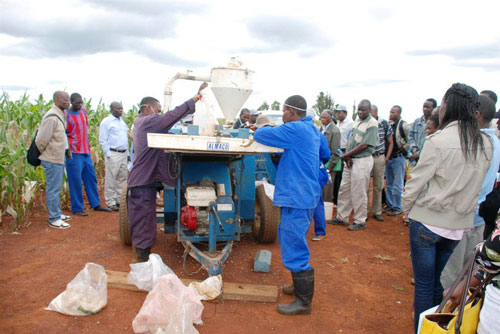The value of CIMMYT’s research work is enhanced through partnerships supporting the development and dissemination of new maize production technologies. To encourage this collaboration, the CIMMYT Southern Africa regional office in Harare, Zimbabwe, holds an annual event during which stakeholders from the ministries of agriculture, academic institutions, seed companies, and donor representatives tour field trials and get acquainted with the station’s research outputs.
On 05 April 2013, the Australian ambassador Matthew Neuhaus together with donor representatives from the European Union, AusAID, and the Swiss Agency for Development and Cooperation joined stakeholders from Zimbabwe, Mozambique, Lesotho, Swaziland, South Africa, and the Democratic Republic of the Congo for a successful partners’ day. Over 200 visitors explored CIMMYT fields, observed various products on the maize breeding pipeline such as trials on drought tolerance, nitrogen use efficiency, and demonstrations on conservation agriculture. Visitors also learned about small-scale farm mechanization for conservation agriculture and management of post-harvest losses through the use of metal silos.
During the field tour, it was evident that CIMMYT is incorporating legumes into maize production systems. This not only includes cover crop that contributes to nitrogen fixing but also grain legumes to improve diversity in the farming households’ nutrition. “CIMMYT is keen to see farmers gain more yield per unit area as opposed to having them increase the acreage under maize,” explained Mulugetta Mekuria, regional liaison officer for southern Africa. “When the maize yield is increased on a small portion of the land, the family can then use the rest of the land to grow high value crops such as pigeon peas that are being successfully exported to India from Mozambique and Tanzania,” he added.
Nutrition was a topic of other parts of the partners’ day as well. Farmers in most of the African continent prefer white maize but where diets are predominantly based on maize, especially with weaned infants, nutritional deficiencies may arise. Two exciting options for overcoming such nutritional deficiencies are quality protein maize (QPM) and vitamin A maize (also called orange maize). The QPM varieties have increased amounts of the essential amino acids lysine and tryptophan thereby enhancing the protein quality of maize and contribute to reducing malnutrition that is often seen in children under five years of age who are commonly weaned on maize porridge. “The mothers may not be able to ensure their children’s nutrition needs with the food they currently have,” said seed systems specialist John MacRobert, as he explained the benefits of QPM varieties. The orange maize has improved levels of pro-vitamin A and may help in alleviating vitamin A deficiency. Two varieties have been released in Zambia and two are in pre-release in Zimbabwe. During the tour, seed company representatives were encouraged to identify pre-release materials in which they may be interested.
The tour elicited a lot of interest from the participants who engaged the scientists in discussions, asked questions, and commented on the benefits of new technologies. Kgotso Madisa, an extension officer from Botswana’s Ministry of Agriculture, highlighted the value of nitrogen use efficient maize for farmers who cannot afford to apply the recommended fertilizer doses. “Most of our smallholder farmers are resource poor, these varieties would be of benefit to them,” said Madisa with reference to the hybrids developed under the Improved Maize for African Soils (IMAS) project.
Arsénio Mutatisse from Mozambique’s Higher Polytechnic Institute of Manica confessed that he had been skeptical about conservation agriculture before the event. However, after hearing agronomist Christian Thierfelder explain how to implement conservation agriculture successfully and after observing the trial, Mutatisse said he was convinced about its benefits. “This event was really helpful for us to see how the varieties perform in trials as we work closely with CIMMYT to ensure they get to the farmers,” said Helene Dinova Nsolani, leader of a group of community seed producers in the Democratic Republic of the Congo.
The partners’ day was made possible through the help of CIMMYT’s national staff and intern students working at the station. Thanks to training provided by the regional office, the students have all the necessary knowledge and were thus instrumental in explaining the technologies on display. “We do capacity building to ensure that whenever we move on, we have people to continue with the breeding work,” explained maize breeder Cosmos Magorokosho.
 The field day was followed by a feedback session and a technical seminar on the maize lethal necrosis (MLN) disease that has emerged recently in East Africa. During the seminar presented by Magorokosho and MacRobert, principal director of the Department of Agriculture Research Services Danisile Hikwa expressed her appreciation to CIMMYT for its efforts to develop MLN resistant varieties.
The field day was followed by a feedback session and a technical seminar on the maize lethal necrosis (MLN) disease that has emerged recently in East Africa. During the seminar presented by Magorokosho and MacRobert, principal director of the Department of Agriculture Research Services Danisile Hikwa expressed her appreciation to CIMMYT for its efforts to develop MLN resistant varieties.
 Climate adaptation and mitigation
Climate adaptation and mitigation 
